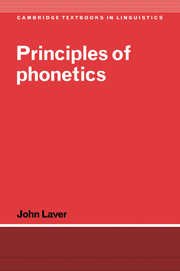Book contents
- Frontmatter
- Contents
- List of figures
- List of tables
- Preface
- Acknowledgements
- Introduction
- PART I General concepts
- 1 The semiotic framework
- 2 The relationship between phonetics and phonology
- 3 Accent, dialect and language
- PART II The analytic framework
- PART III Initiation and phonation
- PART IV Linear segmental analysis
- PART V Articulatory co-ordination and phonetic settings
- PART VI Temporal, prosodic and metrical analysis
- PART VII Principles of transcription
- PART VIII Conclusion
- Envoi
- Appendix I The phonetic alphabet of the International Phonetic Association
- Appendix II Index of languages
- References
- Index of names
- Subject index
1 - The semiotic framework
Published online by Cambridge University Press: 05 June 2012
- Frontmatter
- Contents
- List of figures
- List of tables
- Preface
- Acknowledgements
- Introduction
- PART I General concepts
- 1 The semiotic framework
- 2 The relationship between phonetics and phonology
- 3 Accent, dialect and language
- PART II The analytic framework
- PART III Initiation and phonation
- PART IV Linear segmental analysis
- PART V Articulatory co-ordination and phonetic settings
- PART VI Temporal, prosodic and metrical analysis
- PART VII Principles of transcription
- PART VIII Conclusion
- Envoi
- Appendix I The phonetic alphabet of the International Phonetic Association
- Appendix II Index of languages
- References
- Index of names
- Subject index
Summary
The point of departure for this book is that speech is the most subtle and complex tool of communication that man has ever developed. The aim of this chapter is to discuss the nature of spoken communication, and to offer a broad framework within which the analysis of speech in general, and of spoken language in particular can be set. Some basic concepts are defined for use throughout the book.
One of the most important concepts to be introduced is the notion of the acts of spoken language as artefacts, used as elements of a coded system of signs. As a code, spoken communication can only be successful when used between people skilled in the production and interpretation of the relevant signs. Another very important concept discussed in this chapter is the many-layered nature of speech, with each layer carrying a different type of information. The framework proposed here for the analysis of these concepts comes originally from the discipline of semiotics.
Semiotics as the general theory of signs
Semiotics is the study of all aspects of sign systems used for communication. The term ‘semiotic’ was first used in ancient Greek medicine, to refer to the theory of medical symptoms used in the diagnosis and prognosis of disease (Morris 1946: 285). The Stoic philosophers then used the term to refer to the general theory of signs.
- Type
- Chapter
- Information
- Principles of Phonetics , pp. 13 - 25Publisher: Cambridge University PressPrint publication year: 1994
- 1
- Cited by



